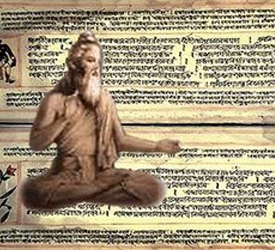You must learn to endure fleeting things they come and go!

Vedic Concepts
Veda is divided into four major parts viz, Samhitas (prayers), Brahmanas (rituals), Aranyakas ( meditations) and Upanishads (The knowledge of self). The first three (Samhita, Brahmana & Aranyaka) are collectively called as Veda Purva (Starting) and the last one Upanishad is called as Veda Anta (ending) or Vedanta. The Veda Purva is also referred as Karma Kanda (Portion dealing with Rituals & Activities) and Vedanta as Jnana Kanda (Portion dealing with The Knowledge of Supreme Self).
Tantras and Agamas
The term Tantra comes from the root ‘Tan’ which means ‘to spread’ and ‘Trai’ meaning ‘to protect’. It also means a thin yarn used in weaving the cloth, to spread knowledge, to achieve the goal or as a technique. Numerous definitions are available for the word since Tantra is not a single evolved system but rather a collection of vast range of ideas and practices of widespread communities having a common denominator. Of these two traditional definitions are popular:
1) “Because it elaborates (tan) copious and profound matters, especially relating to the principles of reality (tattva) and sacred mantras, and because it provides liberation (tra), it is called a tantra.”
2) “A tantra is a divinely revealed body of teachings, explaining what is necessary and what is a hindrance in the practice of the worship of God; and also describing the specialized initiation and purification ceremonies that are the necessary prerequisites of TAntric practice.” Though the word ‘tantra’ can be traced to SaṁhitA and BrAhmaṇa portions of the Vedas, the oldest book in the world and also in various PurAṇas, it has been used in different senses in them.
The Tantra is a technique of using the body as microcosm to join the macrocosm or the ultimate, involving ascent and descent from both the ends [mithuna].
Tantric ritual seeks to access the supra-mundane through the mundane, identifying the microcosm with the macrocosm. Tantra, in the practice, use magic spells, mystic diagrams and gestures as ways of worship. Tantras are believed to be sixty four in number and most of the tantras are Śakti oriented or based on the worship of the Divine Mother.
All of Tantra holds, in direct contradiction to earlier non-dualistic thoughts such as Advaita, that the world is real and not illusory. Therefore the principal aim of tantric practices is not to deny the world and reality, but rather to sublimate it to the Ultimate. The process of sublimation consists of three phases: Purification, Elevation and Reaffirmation of identity on the plane of pure consciousness. Since the world is real, all renunciation of this world is meaningless. Since the Ultimate is both immanent and transcendent, renunciation of the world will not yield any benefits. Because of such beliefs, Tantric practices are mostly suited for householders and in fact in some non-dual forms, Tantra rejects the renunciant ideals contained in Patanjali’s system of Yoga.
According to Tantra, the Ultimate or Truth or Sat-Chit-Ananda (Being-Consciousness-Bliss) is capable of both the evolution or outgoing current or simply, creation and sustenance; and involution or inward current or simply, going back to the Source. Tantra, in a nutshell, is the practice of this ‘returning to the Source’, overcoming the fetters of MAyA .
Tantras are classified as
Dakṣiṇa or Right Wing, VAma or Left Wing and Madhyama or Moderate.
Tantras are also classified into two sub groups, YAmala and ḌAmara.
YAmala is a set of works that deals with the secret communication between the deity and the seeker.
ḌAmara refers to another set of works that deal with the ways of obtaining Divine Knowledge in the same way as ḌAmara, the attendant of Lord Shiva obtained Knowledge from his master.
shivparvati SAKTA AGAMASAccording to one tradition of Tantra, when the knowledge is imparted by Lord Śiva to Devi, His spouse, it is known as Agama and when Devi speaks it is Nigama. Initiation or DikṣA from the Guru and the adherence to rules are most important in Tantras. Tantra as a school of philosophy has gained notoriety due to certain sub schools practising very crude and distorted form of techniques in worship, etc., as compared to the original school that was more sombre and sublime.
The term Agama means ‘that which has come to us. The division between Tantras and Agamas is not mutually exclusive. There is much common ground between them. To a great extent, Agamas owe their allegiance to Vedas compared to Tantra school. They cover many aspects of Hindu life, like worship, temple building, iconometry, civil codes, etc. Like Tantra school, Agamas also use various practices such as mantras and yantras. Devotion to a particular god is most important and this forms the basis for classification of Agamas into various schools. Based on the supreme deity that is being worshipped, Agamas are classified as Śaiva, Vaiṣṇava and ŚAkta Agamas. There exist 28 Śaiva Agamas, 77 ŚAkta Agamas and 215 Vaiṣṇava Agamas, along with their Upa-Agamas.
Śaiva Agamas are divided into KApAla, KAlamūkha, PAśupata and Śaiva Agamas. In Śaiva Agamas, Lord Śiva is the supreme deity.
In ŚAkta Agamas, ŚAkti or Divine Mother is the supreme god.
Vaiṣṇava Agamas, where Lord Viṣṇu is the supreme deity, are said have come from the Divine mouth of Lord Viṣṇu. Vaishnava Agamas are divided into PAncarAtra Agamas and VaikhAnasa Agamas. Almost all the Agamas and majority of Tantras align themselves with the mainstream Hindu thought, though there are some schools in both the systems that are non-Vedic.
